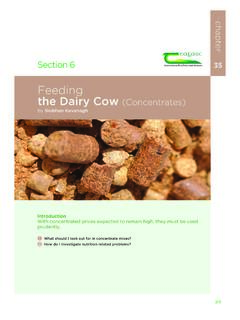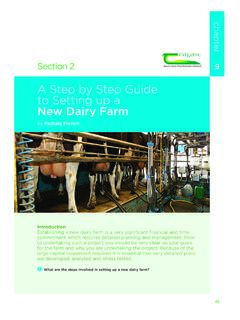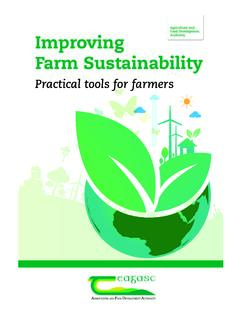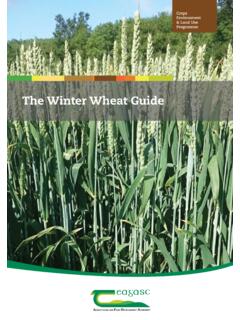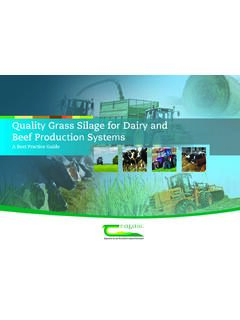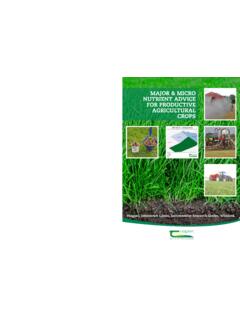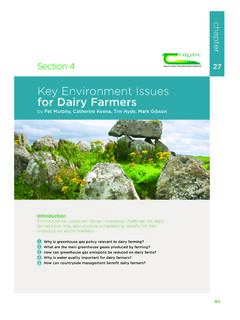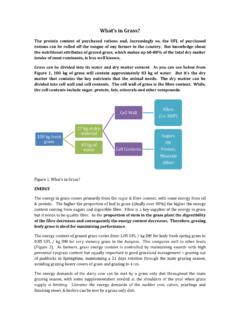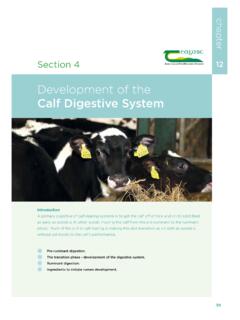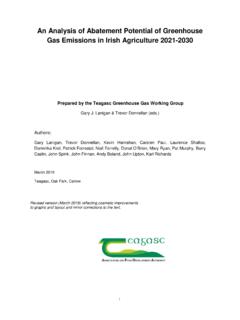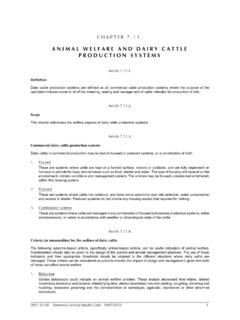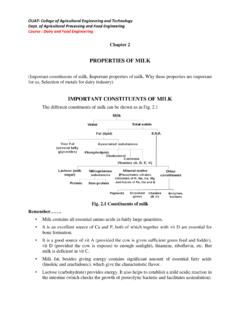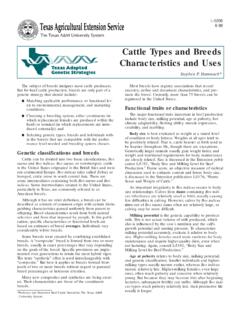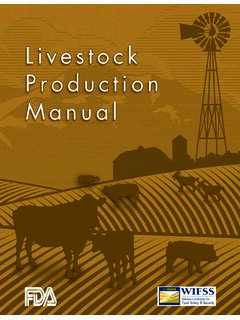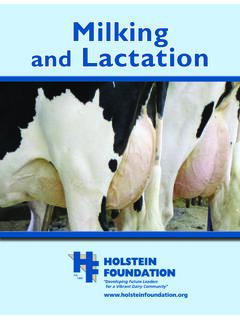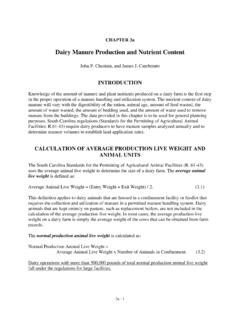Transcription of Feeding the Dairy Cow - Teagasc
1 Chapter Section 6 34. 23. Feeding the Dairy Cow by Siobhan Kavanagh Introduction A Dairy cow must eat a balanced diet with enough energy, protein, fibre, water, minerals and vitamins to cover her own maintenance and growth as well as milk production and the needs of a growing foetus. Quantity and quality are important. 1 What are the feed requirements of the milking cow? 2 What are the feed requirements of the dry cow? 3 How do I optimise my feed costs? 4 What forage options are available to me? 201. chapter Feeding 34 the Dairy Cow 1 What are the feed requirements of the Key performance indicator milking cow? The milking cow should receive adequate feed to optimise SPRING milk solids production and keep body weight loss to less than BCS between calving and breeding.
2 A cow will reach her highest daily milk output 6-8 weeks after calving but will only reach her highest intake of dry Checklist matter 10-12 weeks after calving. The cow will use energy from her fat reserves ( off her back') to make up the energy Which factors can cause low dry matter deficit for several weeks. However, if the cow loses too much intake? body condition in early lactation , it can reduce her chances of Low Dry Matter forage getting back in calf again. Lack of Overestimation protein of grass supply Cows calving onto a grass-based diet will eat a total dry matter intake (DMI) of 8-10kg DM (grass + concentrates) in Metabolic Low digestibility week one after calving.
3 Intake will increase by Diseases forage DM every week until they reach peak intake at 16-18kg DM Low Dry Matter Intake? during week 10-12 of the lactation . Feed Poor access to spoilage drinking water In spring, the aim is that the cow should graze a high amount of quality grass with appropriate supplementation. When less than 8kg of grass dry matter per cow is available, the deficit Poor grazing Low pre-grazing conditions covers should be made up with a forage grass silage, as well as Over conditioned cows concentrate. This will ensure the cow is getting enough fibre. Stop Feeding silage when enough fresh grass is available. Checklist Key fact Intake drives performance in the spring How do I know if an animal's dry matter intake is low?
4 Calving herd. Estimates of intake (kg DM/cow/day) 1. Excessive body weight loss 19. 19-23 2. Low milk yields 16-18. 17 3. Low milk solids 15-17. 15 4. Poor fertility 5. Metabolic diseases kg DM. 13. ! 11. Key risk 9. If body condition loss in early lactation 7. milking cow indoors on grass Winter milk indoors using Grazing cow (peak intake) is BCS or greater, cow fertility will suffer. silage + meals grass silage and an alternative forage The effect of body condition loss on three week submission rate (maize silage). 100. Winter milk herds Decrease supplementation rates by 1 2kg if using a blend of 80. 3 week submission rate forages - grass silage plus maize silage or whole crop cereal 60.
5 Silage. 10kg of fodder beet is equivalent to 2kg ration, but 40. balance for protein. 20. 0 <= >= to > Body condition loss 202. chapter 34. 23. Supplementation required Key risk There is no grass available for grazing. ! = Cow requirements for energy - grass energy intake. This applies to winter Feeding for autumn Rule of thumb calving herds and in severe situations where Six to eight weeks after calving 13kg DM of grass plus no grazed grass is available in spring. The kg as fed concentrates will deliver a peak yield of following supplementation rates apply: milk solids (28 litres/6 gallons). If less grass is available, more supplements will be needed.
6 If output is Kg concentrate/cow/day lower, then supplementation rates can be reduced (see diagram). As intake capacity increases, the cow will gradually Silage DMD (%) 75% 70% 65% reach peak intake of 16-18kg of grass dry matter. Dry + well preserved Supplement (27 litres) Rule of thumb Supplement (32 litres) An increase of 1% in grass digestibility will increase dry matter intake by DM and milk yield by Increase by 1-2kg if silage is wet and/or poorly preserved litres. Targets for total diet composition for winter milk Dairy cows Supplementation rates for a spring Lactating Cow calving herd Early-peak1 Mid-late Dry cow Dry matter intake Spring High yield (kg/day) (Target peak yield = milk solids) cows Energy UFL (per kg DM) Scenario 1.
7 13kg DM grass, no grass silage Fibre (min): NDF (%) 32 - - + concentrates ADF (%) 21 - - Starch (max) 22 - - Scenario 2. 12kg DM grass, no grass silage Oil (max) 5-6 - - + concentrates Protein PDI (g/kg DM) 105-110 95 70. Crude protein (%) 17 15-16 13 Scenario 3. Mineral profile (% of diet) 8kg DM grass + grass silage + 6kg concentrates Ca P Na Spring Medium yield Mg (Target peak yield = milk solids) cows 1 peaking at 38-40kg milk Scenario 1. How to 14kg DM grass, no grass silage + 1kg concentrates Manage supplementation at grass Scenario 2. in spring 12kg DM grass, no grass silage + 2kg concentrates Supplementation rates will be dictated by cow production level and grass availability.
8 Scenario 3. 8kg DM grass + grass silage + 4kg concentrates Grass budgeting is an important decision support tool in deciding on a supplementation strategy. Increase supplementation rates by 1-2kg as milk solids production increases by 203. chapter Feeding 34 the Dairy Cow . Key fact Cows can't get quick access to water Dairy cows can drink more than half of their water needs Energy, not protein or minerals, is the most limiting nutrient in Dairy production systems. If animals are not milking as well within a few hours of milking . Cows can drink quickly - up as expected, or milk protein is low or cows are losing to 14 litres(3 gallons)/minute. It is important that the excessive condition, energy is the first nutrient to check.
9 Infrastructure and water flow rates adequate to meet the Check the total dry matter intake of the animal as well as demands of the herd. See also Grazing Infrastructure. the quality ( energy content) of the forages/feeds used. Minerals and vitamins Digestive upsets Get the mineral status of your grazed grass checked regularly Build up concentrate levels gradually to reduce the risk. so that you get the correct mineral formulation to meet the Pay particular attention to first calvers when Feeding high needs of the herd. concentrate levels. Checklist Insufficient energy in the cow's diet Minerals for the milking cow Insufficient energy in the milking cow's diet can result in low 1.
10 Ensure that the inclusion rate of magnesium matches the milk protein, low milk yields, poor fertility, poor immunity requirements of the cow during the tetany period for susceptibility to disease and metabolic disorders including different Feeding rates. ketosis etc. as well as loss of body condition. Feeding rate kg % calmag needed in ration to supply 60g per cow/day calmag or 30g of magnesium Not enough protein 60g calmag (%). 1. In early spring the level of protein in spring grass is high, 1 but the quality may not be adequate for the freshly 2 calved cow. 3 4 2. In mid-summer during a drought situation when grass 5 becomes stemmy, protein levels in the grass can drop and 6 may limit production.
